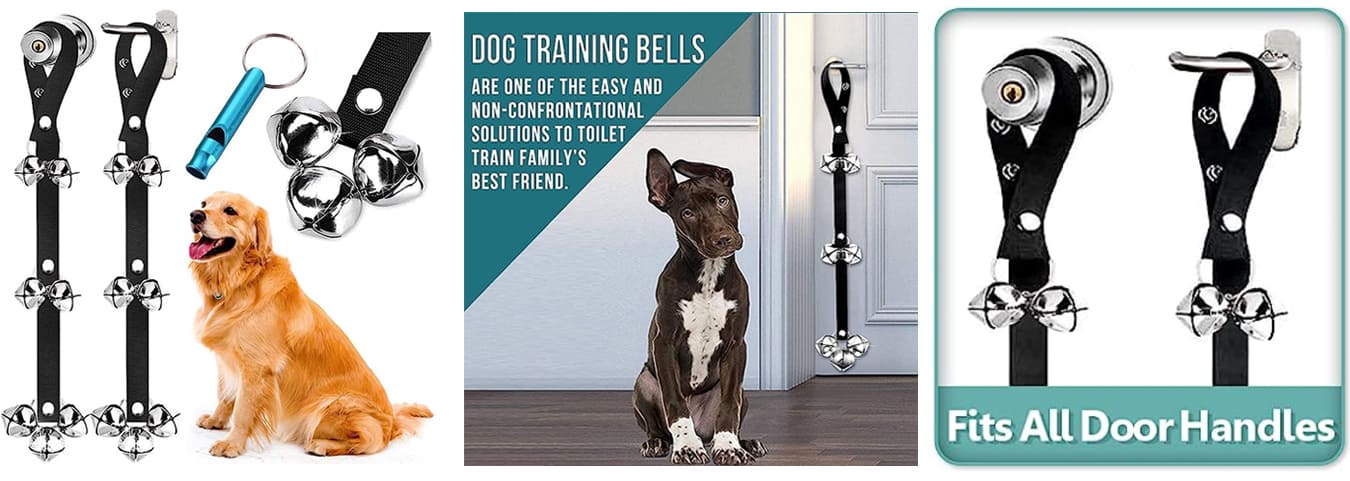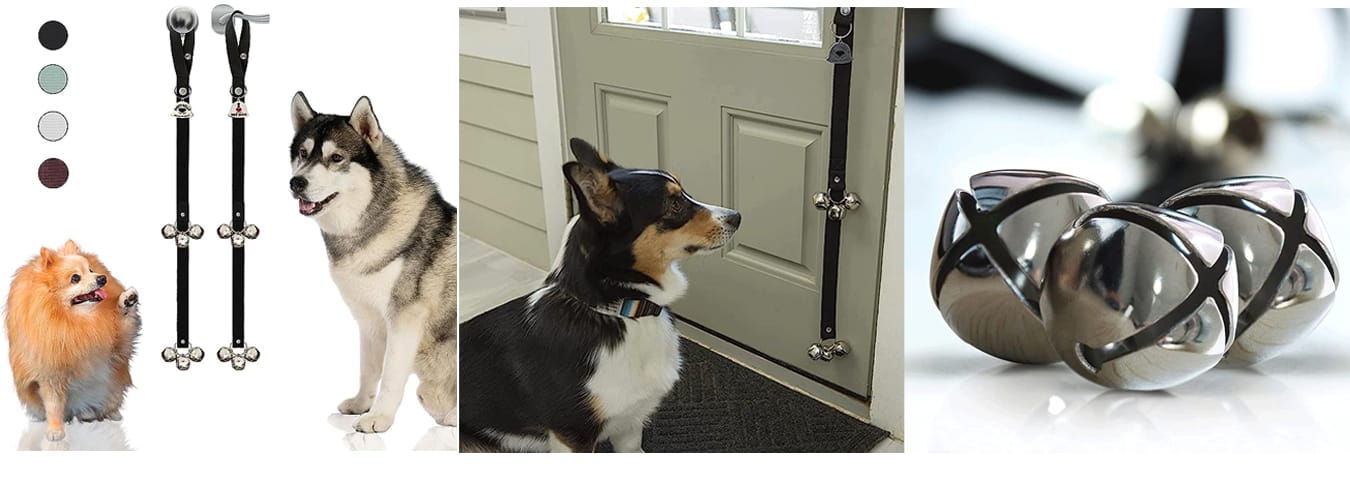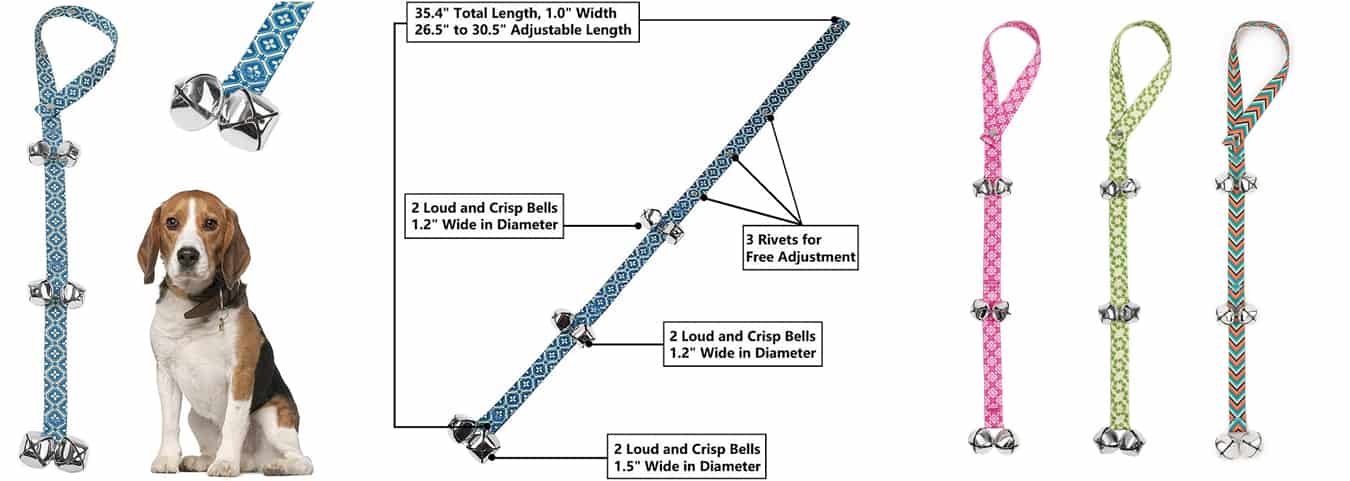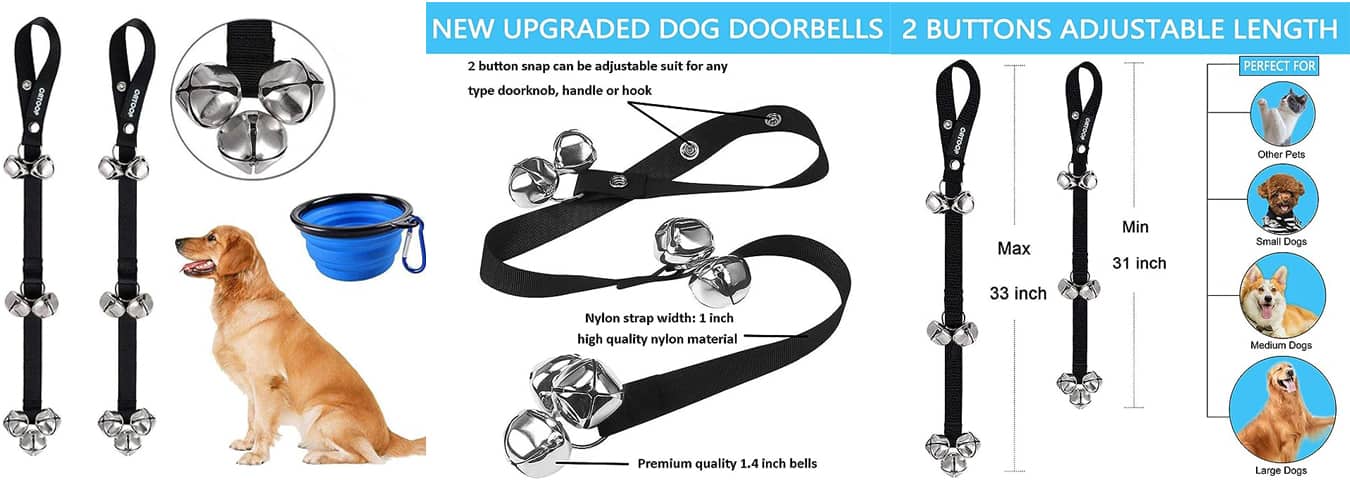Welcoming a new puppy to your home is exciting but not when frequent bathroom accidents ruin the sweet, special moments. Puppies are just like any other baby – they need help with going to the bathroom. And, no matter how much you love them, you certainly don’t want to taint your home’s floors with dog poop.
If you’re looking for the best way to potty train your dog, we have the perfect solution for you. A potty bell is a perfect way to train your dog with recognizable audio commands. Are you looking for the perfect dog potty training bell? We have you covered!
Top 5 Dog Potty Training Bells
Puppies are smart, but they need the right mental and sensory stimulation to be trained. So, here are our top five picks on the best bells to potty train your dog.
1. BLUETREE Dog Doorbells Premium Quality Training Potty Great Dog

The BLUETREE dog doorbells come in a set of two. Unlike other cheaper alternatives with only a two-level ball height, BLUETREE offers a three-level adjustable height. This means you can use this bell for a dog of any breed and size, and you can position the bell wherever you think is best suited for your dog.
The jingle bells are made from solid and durable metal and painted with a coat of silver to keep them shiny and attractive. Say your dog decides to keep playing with the bell. In that case, you don’t have to worry about noise irritation because the jingle sound is very pleasant.
The belt of the bells is made of high-quality nylon, which is resistant to bites and pulls. Together, the bells produce a loud and clear sound that lasts longer than cheaper alternatives available on the market.
The brand also has exceptional customer service. For instance, each customer who purchases the two-pack doorbell for potty training also gets a free dog training whistle.
Specifications:
- Brand: BLUETREE
- Material: Steel and nylon
- Dimensions: 3 x 3 x 3 inches
- Weight: 1.06 ounces
|
|
2. Caldwell’s Pet Supply Co. Potty Bells

If you’re looking for the best quality doorbells for potty training your dog, this product by Caldwell is the ultimate catch. The bells are designed with thick-walled durable steel and coated with nickel to prevent rusting. And the straps are made of water-repelling, high-quality woven nylon – the best material in the industry to pair with potty training bells.
The nylon straps are adjustable and can be increased or decreased to 30 or 32 inches, making them perfect for puppies of all breeds and sizes. Each belt also consists of the brand’s signature removable accessory, which doubles up as a key chain.
The belt features six jingle bells that produce a pleasant, loud, and clear sound that’s not shrill and irritating. You can buy either one or a set of two doorbells depending on the number of dogs you have and your personal requirements.
One of the standout features of these potty belts is the variety they offer in terms of colors. Unlike other brands, you can choose from vibrant shades like green, red, black, blue, etc. Choose a shade your dog likes and one that goes the best with your decor.
Specifications:
- Brand: Caldwell
- Material: Steel, nylon, and nickel
- Dimensions: 5.79 x 4.09 x 0.91 inches Weight: 4.96 ounces
|
|
3. Pet Heroic Dog DoorBells for Potty Training & House Training

These potty training bells by Harfkoko are perfect for both the dog and the owner. It works for the dog owner because it comes with different prints and designs to match their home aesthetics. And it works for dogs because it’s easy to use, non-intimidating, and made of high-quality materials.
The belt comes with six durable and loud jingle bells and three rivets to adjust the straps’ height. The bells have a super loud and distinct sound that is audible even to people with hearing issues.
An adorable feature of this product is that the brand recognizes the struggle of new dog owners in potty training their dogs with a potty bell. That’s why they have included a six-step training guide with each product to overcome this challenge.
Moreover, this product is perfect for dogs of all breeds and sizes. Hang it wherever you want and let the bells cast their magic – metaphorically speaking!
Specifications:
- Brand: Harfkoro
- Material: Not specified
- Dimensions: 7.87 x 4.72 x 1.57 inches Weight: 3.68 ounces
|
|
4. CATOOP Dog Doorbells Premium Potty Training Bells

If you’re worried that six bells might not be enough to create a sound loud enough to be heard all across your home, try this set of potty training doorbells by Catoop that comes with an extra bell in every belt.
Each snappable belt has seven large jingle bells. You’re free to integrate two belts into one to adjust the height of the bells for different breeds and sizes.
The sound from the bells is rather pleasant and resembles Christmas bells so that the continuous ringing by your dog won’t annoy you. The belt straps are made of high-quality nylon, which is undoubtedly the best-in-class material in the industry for dog doorbells. They last longer and staff better than any other material in the market.
The best part is that each customer gets a free dog food bowl and the doorbells as a complimentary gift from the brand. The bowl has a collapsible design that you can store in compact spaces or carry on your trips.
Specifications:
- Brand: Catoop
- Material: Metal and nylon
- Dimension: 8 x 4 x 1 inches
- Weight: 1.6 ounces
|
|
5. PAWBEE Dog Doorbell – Set of 2 Adjustable Dog Training Bells

This is yet another pair of extraordinary doorbells for potty training your dog that comes with seven large jingle bells and is suitable for small and large breeds alike.
The belts are made of heavy-duty nylon and stainless steel. The former does not wear out despite regular use, and the latter is resistant to corrosion and rusting. Even the stitching between the bells and the strap is strong enough to ensure better durability, no matter how aggressive your new puppy is.
Each belt consists of two bells at the top and middle followed by a group of three bells towards the end. Together they make a blaring and clear yet pleasant sound that’s easy on your ears and ensures you never miss out on any ring.
The adjustable belt allows you to juggle between 32 to 33 inches, making it perfect for dog owners with different breeds.
A notable feature of this belt is that it does not disrupt the aesthetic brilliance of your home. With sleek and stylish black belts holding seven shiny, chromium-coated bells, these doorbells will go with just about any decor.
Specifications:
- Brand: Pawnee
- Material: Steel, nylon, chromium
- Dimensions: 8.86 x 6.61 x 2.24 inches
- Weight: 7.83 ounces
|
|
Mistakes to Avoid While Potty Training Your New Pup
Puppies are creatures of habit. While this trait turns out to be very helpful while training, it can be equally challenging if you accidentally train them for the wrong activities.
Here are a few grave mistakes that you should avoid while potty training your new dog:
1. Avoiding Large Crates
When you get a new pup, the idea of putting them up in a crate might seem horrifying at first. But you will soon realize that dogs are den animals. So, if you don’t provide them with a personal space of their own, they will find a corner for themselves in your home.
When you buy a new crate, make sure it’s not too big. Just leave enough space for your dog to sleep, stand up and turn around. If you settle them in a giant crate, they will find a corner to relieve themselves and will not bother stepping out of it to poop.
2. Too Much Freedom
Dogs need to be well trained before giving them the freedom to go about your house as they please. While it’s exciting to welcome a new puppy into your home and let them be free to explore it, doing so would mean you are setting yourself up for a potty training failure.
Your dog needs to be on a leash for the first few weeks, even when inside the house. For example, if they are always in front of your eyes, you will be able to stop them from pooping on your carpets.
Simply say a stern “No” and take them outside to poop. Now, this is not to say that you won’t have a few accidents inside the house initially – you certainly will, but it will eventually teach your dog not to poop indoors.
3. Potty Pads
It can be tempting to put your puppy in a potty pad while they are still learning to identify the right areas to relieve themselves. However, potty pads are a huge hurdle in their learning journey.
If you want the training to be quick and effective, don’t make it too confusing for your pup. Once it gets used to potty pads, it will never learn the difference between pooping outside and inside.
We only recommend using a potty pad when absolutely necessary. For example, a potty pad would be the perfect choice if it’s raining cats and dogs outside and your pup is too scared, or if you are at a friend’s place with no opportunity to potty train your little furry friend.
4. Failing to Teach the “Go Potty” Command
No matter how smart dogs are, they cannot be trusted with choosing their own bathroom schedules in their initial days. So, it’s important to teach them the go potty command.
You can do this by taking your dog out every day at set intervals and giving the “Go Potty” command. Make sure you don’t give them more than five minutes. If they poop by then, great. Take them inside until the next potty break.
You can also try picking them up and bringing them outside every time you see them trying to relieve themselves in your house. But before you let them get about the job, always give the “Go Potty” command. This will teach them that any time they hear this word, it’s time to poop.
5. Yelling at Your Dog
It can be frustrating to see an unwanted mess on your precious floors or living room carpet. However, it’s important to understand that it’s a dog’s natural instinct to relieve themselves wherever they feel like it, especially in their early years. Yelling or spanking your dog will make them fear you, which is not a good environment for them to be trained in.
Be firm in your approach but also ensure that you build a strong bond with your pooch. Dogs learn best with positive reinforcement and perform best when happy.
6. Not Rewarding Small Achievements
A dog’s life is simple. If it gets a delicious treat and rewards for doing something once, it will certainly do it again. One of the biggest mistakes new dog owners make is not rewarding their pup’s small bathroom achievements.
As we mentioned before, dogs learn faster with positive reinforcement, so anytime they successfully relieve themselves outside, treat them with their favorite food or give them encouraging words and lots of praise and pats.
This will help them learn that what they just did was indeed very good behavior, and they will continue to do so in the hope of more love and reward.
7. Leaving the Door Open
Leaving the door open might seem like the perfect solution, especially in summers. Your puppy gets to relieve themselves whenever they want, and you don’t have to worry about indoor accidents.
However, this practice does not teach them to hold themselves or not poop when the doors are closed. Being slightly rigid in the beginning is the only way to ensure your puppy grows into a responsible big dog.
8. Not Being Patient Enough
Training a dog doesn’t involve a magic wand. It takes a considerable amount of time for your dog to learn the right time and place to relieve themselves.
In the meantime, all that you can do as a responsible owner is support them through the process, help them learn faster, and appreciate their small wins.
Make sure you’re not too impatient or rough on your puppy during the learning days. Being rude to puppies can trigger severe anxiety, which can last a lifetime if you keep up the behavior.
Why You Should Use Bells and Buttons to Potty Train Your Dogs
Puppies cannot be nurtured the same way as humans – obviously! Although they are smart, you can hardly do anything to alter their natural instincts. However, what you can do is teach them to react to certain external stimuli in your chosen manner.
Training tools like bells and buttons produce an audible and distinct sound, which doubles as an excellent external stimuli. It will ensure that:
- Your dog has an easier time learning to poop outside.
- There are fewer accidents indoors.
- Your dog is clearly able to communicate with you.
Bells work the same way your voice works: they act as a command perceived to have a connection with a certain task.
Many new dog owners also resort to buttons to improve communication with their furry friends. These buttons work with human language, meaning that every time your dog presses them, it’ll give a command in your language.
Buttons are used for multi-activity training and are slightly more complex than the bell method. If you just want to potty train your dog at the moment, we recommend sticking to bells.
How to Potty Train Your Dogs With a Doorbell
Bells are one of the easiest and most effective ways to train a dog for anything and so they can relieve themselves outdoors. The bell sound doubles up as the dog’s voice and bridges the communication gap between the pooch and the owner.
Here’s a quick guide on how you can potty train your dog with a doorbell:
1. Acquaint the Dog With the Bell
Before you even begin training your dog, you need to acquaint it with the bell. Carefully unwrap the product’s packaging and hand it over to your dog. Let it play around with the bells and sniff it all it wants.
In the process, it will slowly understand the bell does not pose any threat to it, making it more likely to use it faster. Once your dog is done playing with the bell, make sure you give them treats or appreciate the effort with pats and appreciative words.
2. Establish the Connection Between Pooping and Bells
Dogs are pretty smart. Once you establish the connection between two events – the ringing of the bell and a certain action afterward – they are likely to pick it up and execute it themselves. So, each time you take them out to go potty, make sure you ring the bell before stepping out.
We recommend you put the bell on the door you most frequently use to take your dog out to relieve themselves. By repeating this behavior every day, your dog will slowly start to see a connection between going out for potty and using the bell.
Sure, it might take some time for your dog to understand that those bells are only used when they have to poop and not just any time they want to go outside. But they will start using the bells sooner rather than later to let you know that they have to go potty.
3. Appreciate Small Milestones
It might take a while for your dog to get into the habit of ringing the bell every time they need to poop, but that does not mean you should not appreciate their smaller achievements. Any time your dog is remotely interested in the bell before going out or tries to ring it, appreciate their improvement with treats and pats.
This will help your furry friend see ringing the bell as positive behavior, and they will then try to repeat and get better at it every day. You can also use soft treats as a means to differentiate between different uses of the bell. For example, if you only want your dog to ring the bell when it has to poop, treat it only when it uses the bell for the correct reason, i.e. to poop.
Wrapping Up
Each of these dog potty training bells offers equally exciting features and benefits. So, it’s natural for you to be still confused about which one is the best for you. Here’s a quick recap to help you choose faster and better:
- If you want a bell for dogs of different breeds and sizes, go for the BLUETREE Dog Doorbells Premium Quality Training Potty Great Dog.
- If you want a stylish bell that goes well with your home decor, pick the PAWBEE Dog Doorbell – Set of 2 Adjustable Dog Training Bells.
- If you want seven bells instead of six on a single bell for a louder sound, the CATOOP Dog Doorbells Premium Potty Training Bells is what you should be looking at.
- The Pet Heroic Dog DoorBells for Potty Training & House Training comes with a six-step guide, making it the easiest to get started with.
- Pick Caldwell’s Pet Supply Co. Potty Bells if you need dog potty training bells of the highest quality.

